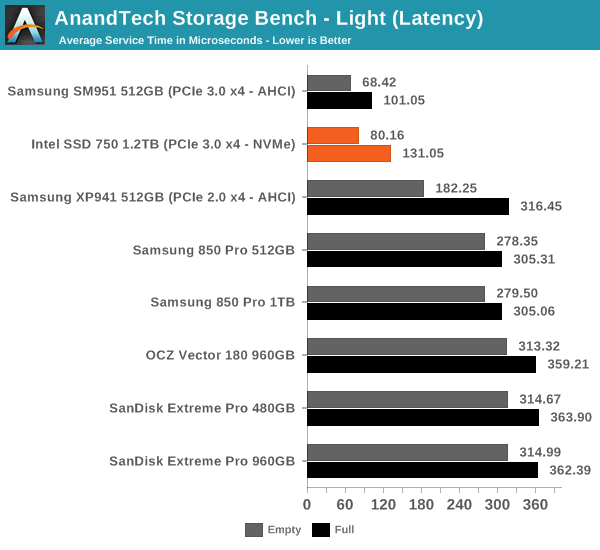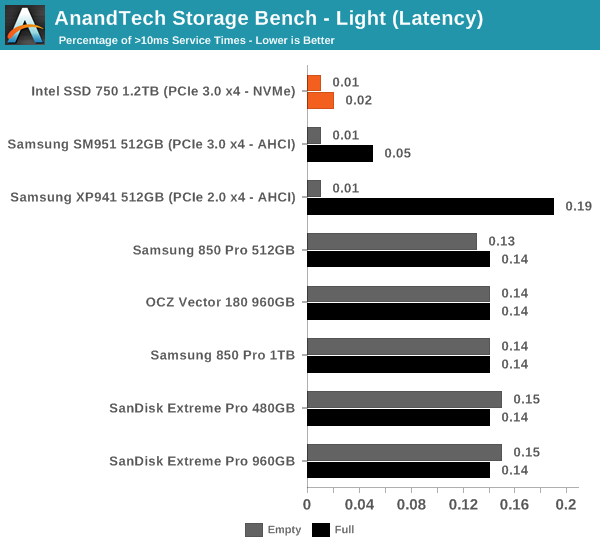Intel SSD 750 PCIe SSD Review: NVMe for the Client
by Kristian Vättö on April 2, 2015 12:00 PM ESTAnandTech Storage Bench - Light
The Light trace is designed to be an accurate illustration of basic usage. It's basically a subset of the Heavy trace, but we've left out some workloads to reduce the writes and make it more read intensive in general.
| AnandTech Storage Bench - Light - Specs | ||||||||||||
| Reads | 372,630 | |||||||||||
| Writes | 459,709 | |||||||||||
| Total IO Operations | 832,339 | |||||||||||
| Total GB Read | 17.97 GB | |||||||||||
| Total GB Written | 23.25 GB | |||||||||||
| Average Queue Depth | ~4.6 | |||||||||||
| Focus | Basic, light IO usage | |||||||||||
The Light trace still has more writes than reads, but a very light workload would be even more read-centric (think web browsing, document editing, etc). It has about 23GB of writes, which would account for roughly two or three days of average usage (i.e. 7-11GB per day).
| AnandTech Storage Bench - Light - IO Breakdown | |||||||||||
| IO Size | <4KB | 4KB | 8KB | 16KB | 32KB | 64KB | 128KB | ||||
| % of Total | 6.2% | 27.6% | 2.4% | 8.0% | 6.5% | 4.8% | 26.4% | ||||
The IO distribution of the Light trace is very similar to the Heavy trace with slightly more IOs being 128KB. About 70% of the IOs are sequential, though, so that is a major difference compared to the Heavy trace.
| AnandTech Storage Bench - Light - QD Breakdown | ||||||||||||
| Queue Depth | 1 | 2 | 3 | 4-5 | 6-10 | 11-20 | 21-32 | >32 | ||||
| % of Total | 73.4% | 16.8% | 2.6% | 2.3% | 3.1% | 1.5% | 0.2% | 0.2% | ||||
Over 90% of the IOs have a queue depth of one or two, which further proves the importance of low queue depth performance.

The same trend continues in our Light trace where the SM951 is still the king of the hill. It's obvious that Intel didn't design the SSD 750 with such light workloads in mind as ultimately you need to have a relatively IO intensive workload to get the full benefit of PCIe and NVMe.












132 Comments
View All Comments
perula - Thursday, April 9, 2015 - link
[For Sell] Counterfeit Dollar(perula0@gmail.com)Euro,POUNDS,PASSPORTS,ID,Visa Stamp.Email/ perula0@gmail.com/
Text;+1(201) 588-4406
Greetings to everyone on the forum,
we supply perfectly reproduced fake money with holograms and all security features available.
Indistinguishable to the eye and to touch.
also provide real valid and fake passports for any country
delivery is discreet
We offer free shipping for samples which is 1000 worth fake as MOQ
oddbjorn - Tuesday, April 14, 2015 - link
I just recieved my 750 yesterday and soon found myself slightly bummed out by the lacking NVMe BIOS-support in my ASUS P8Z77-V motherboard. I managed to get the drive working (albeit non-bootable) by placing it in the black PCIe 2.0 slot of the mainboard, but this is hardly a long term solution. I posted a question to the https://pcdiy.asus.com/ website regarding possible future support for these motherboards and this morning they had publised a poll to check the interest for BIOS/UEFI-support for NVMe's. Please vote here if you (like me) would like to see this implemented! https://pcdiy.asus.com/2015/04/asus-nvme-support-p...Elchi - Wednesday, April 15, 2015 - link
If you are a happy owner of an older ASUS MB (z77, x79, z87) please vote for NVme support !http://pcdiy.asus.com/2015/04/asus-nvme-support-po...
iliketoprogrammeoo99 - Monday, April 20, 2015 - link
hey, this drive is now on preorder at amazon!http://amzn.to/1DDKwoI
only $449 on amazon.
vventurelli74 - Monday, May 4, 2015 - link
Lets say I had an Intel 5520 Chipset based computer that has multiple PCIe 2.0 Slots. I would be able to get almost the maximum read performance (Since PCIe 2.0 is 500MB/s per 1X, 4X = 2000MB/s, which is exciting on an older computer. I am curious as to if this would be a bootable solution on my desktop though. With 12 Cores and 24 Threads, this computer is far from under-powered, and it would be nice to breath life into this machine, but the BIOS would have no NVMe support that I can think of. I know it has Intel SSD support, but this is from a different era. I wish someone could confirm that this either will, or will not be bootable on non-MVMe mobo's. I am getting conflicting answers.vventurelli74 - Monday, May 4, 2015 - link
Nevermind, finally found the requirements that this drive will not be bootable on on NVMe machines, whats more is even using it as a 'secondary' drive requires UEFI apparently. My computer wouldn't be able to use this card at all? That would suck.xyvyx2 - Friday, May 8, 2015 - link
Great review!Kristian, any chance you have two of these drives in the same machine & you could test RAID0 performance? I'm running into some slow read performance when using two Samsung PCIe drives in a Dell server w/ a RAID1 or RAID0 config. It's not like regular bottlenecking where you hit a performance cap, but where transfer rate drops down to ~ 1/5th the speed at a lower xfer rate.
I thought this was just a Storage Spaces problem, but the same holds true w/ regular windows software raid. I got up to about 4,200 MB/sec, then it tanked. I then ran two simultaneous ATTO tests on two of the drives and they both behaved normally & peaked at 2,700 MB/sec... so I don't think I'm hitting a PCIe bus limitation... I think it's all software.
I posted more detail on Technet here:
https://social.technet.microsoft.com/Forums/en-US/...
shadowfang - Saturday, September 26, 2015 - link
How does the pcie card perform on a system without nvme?